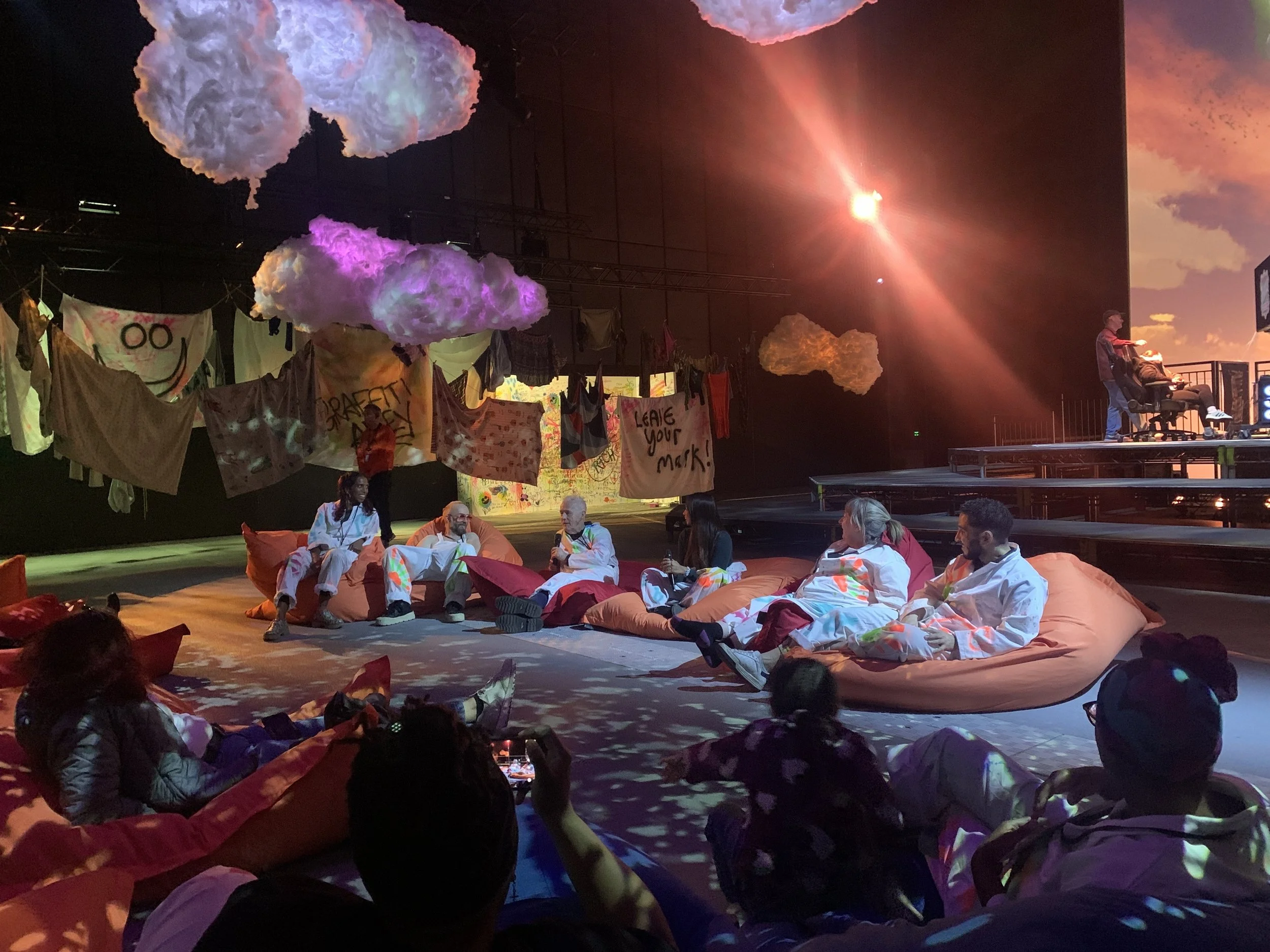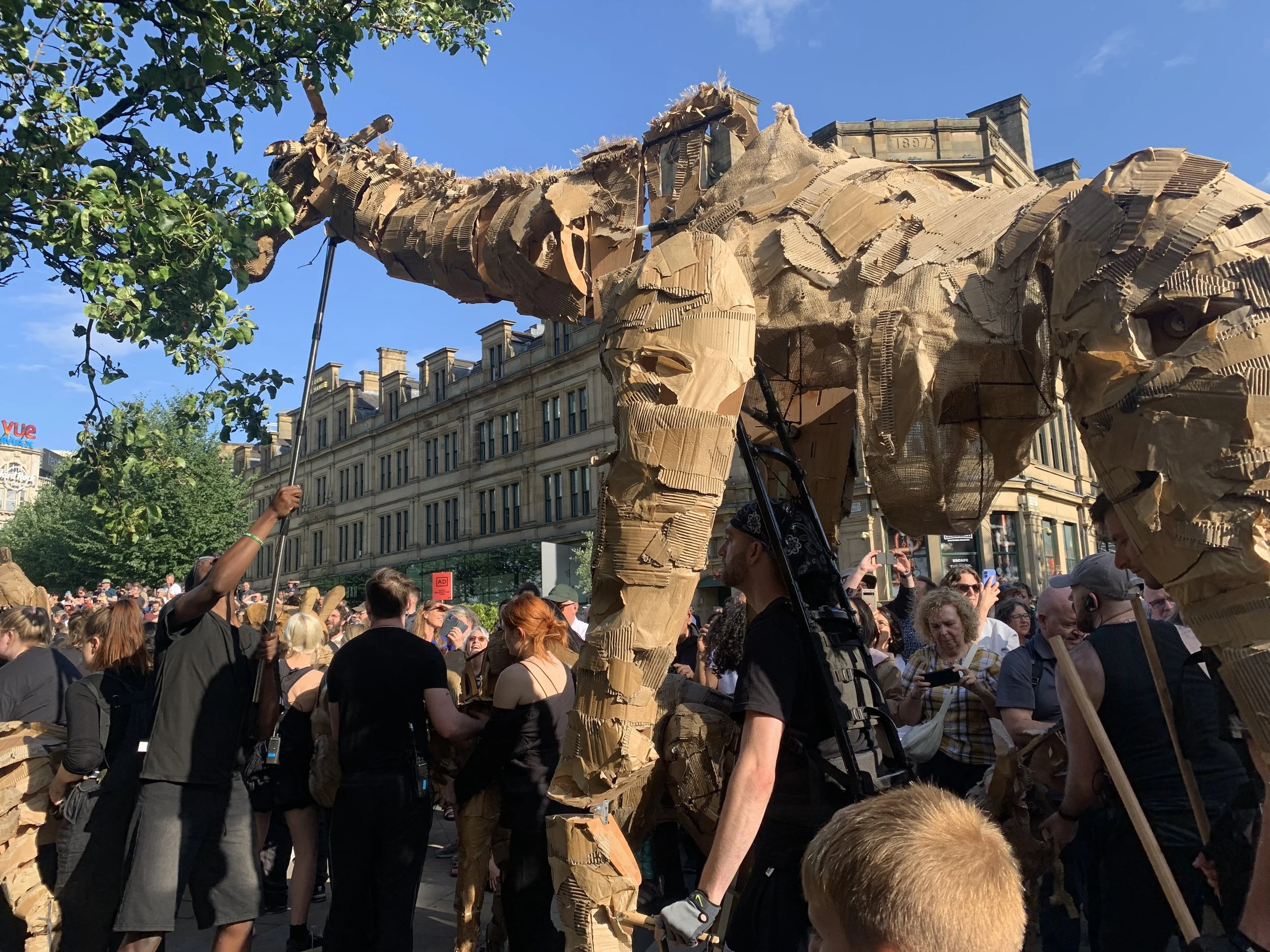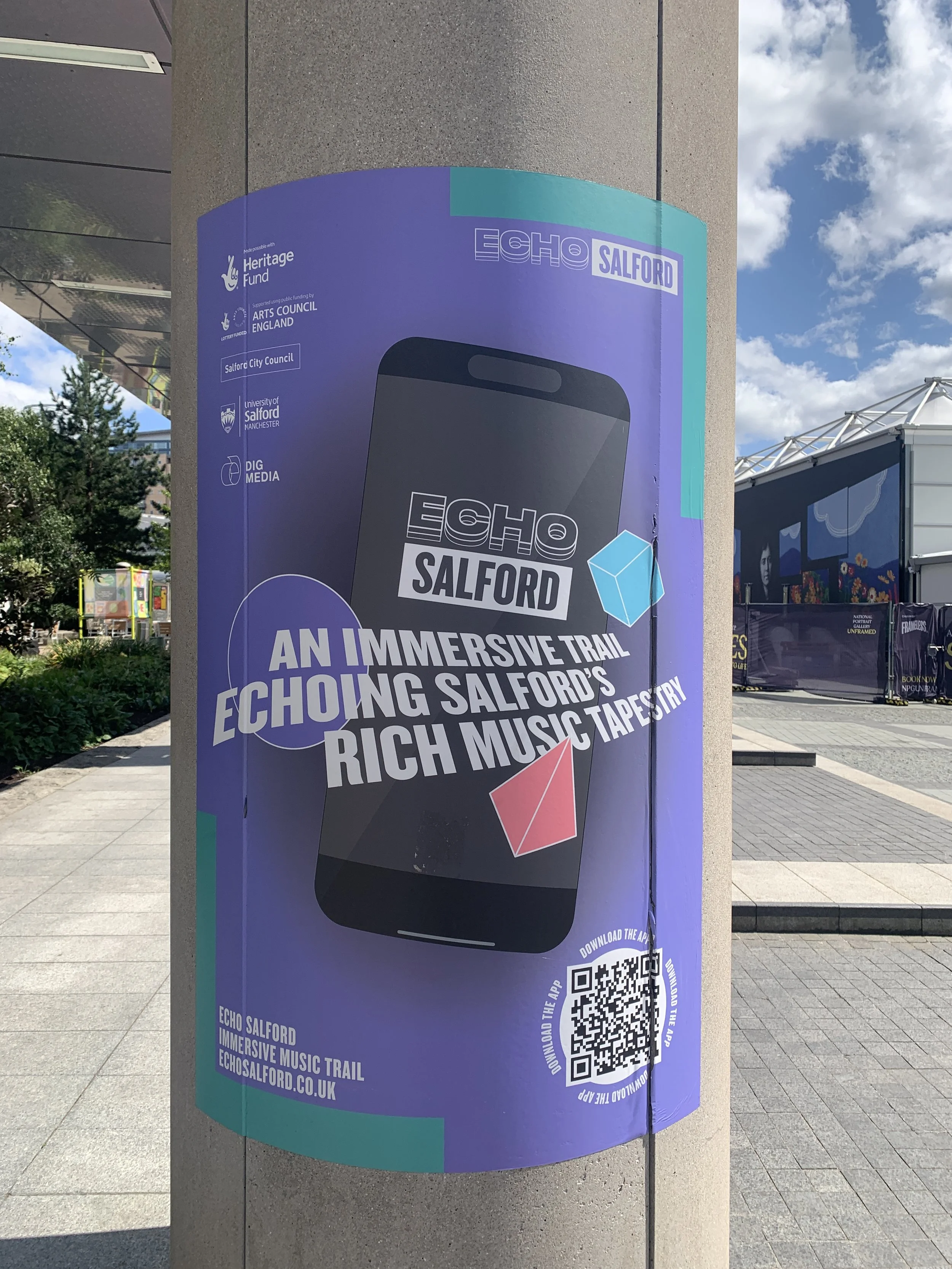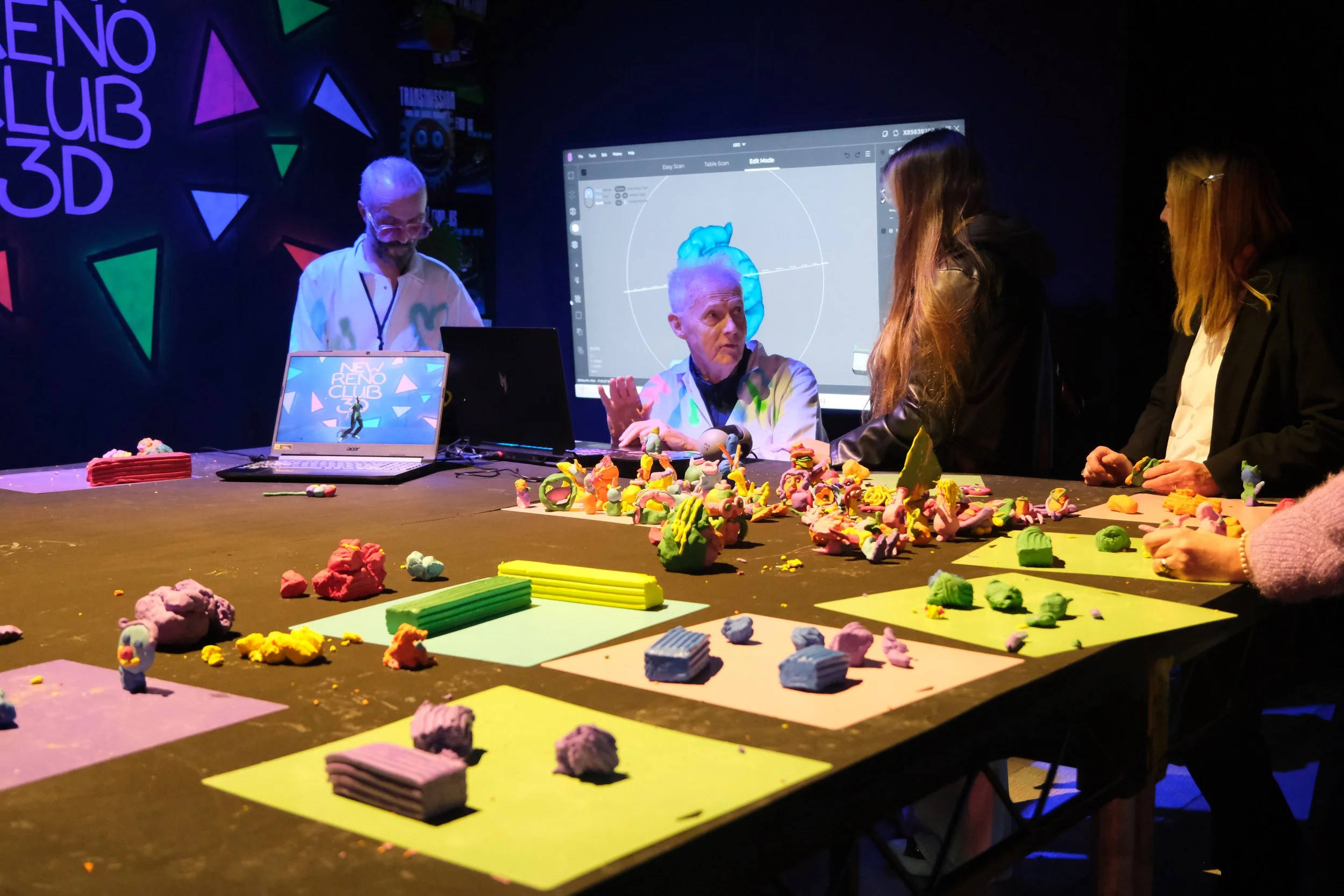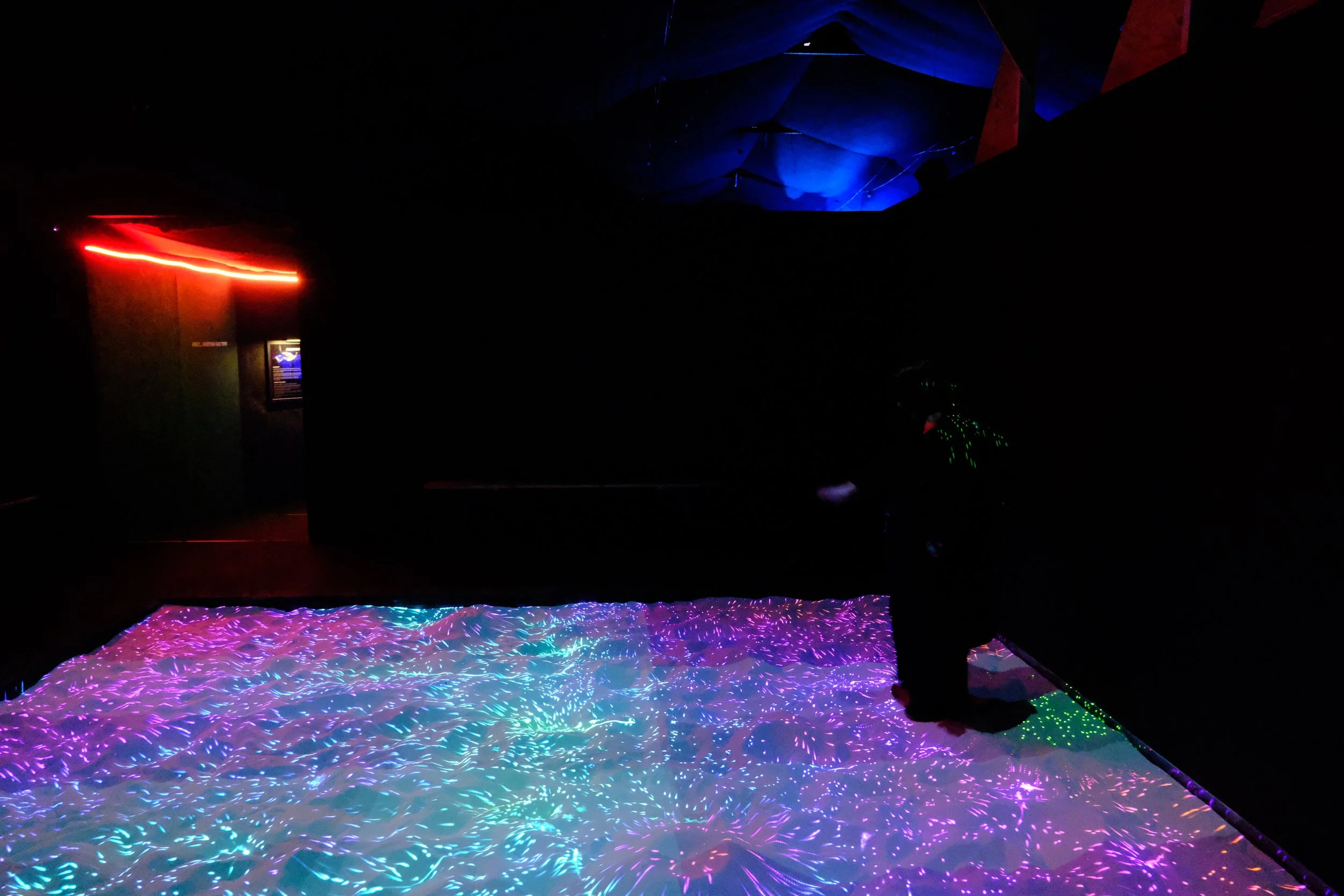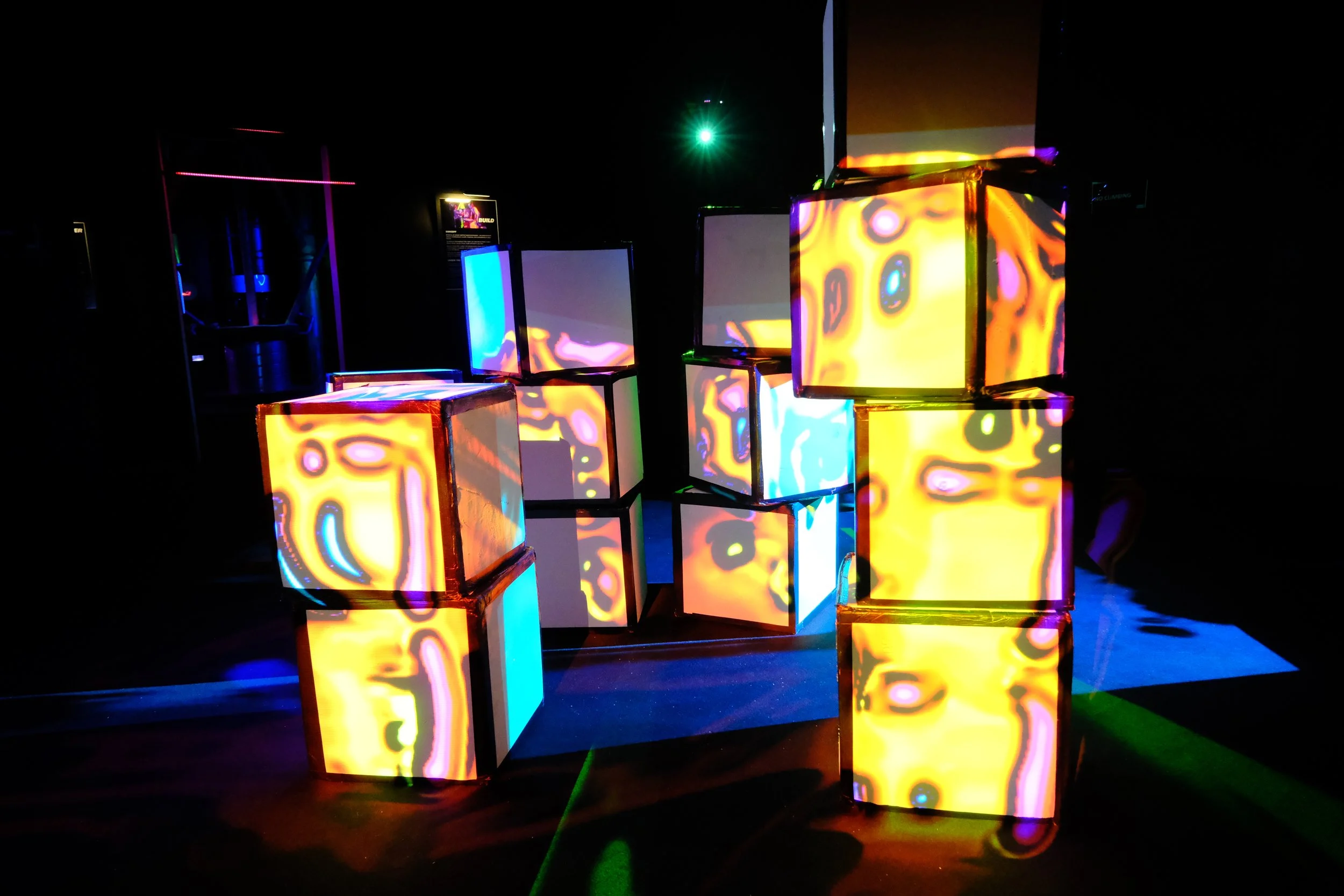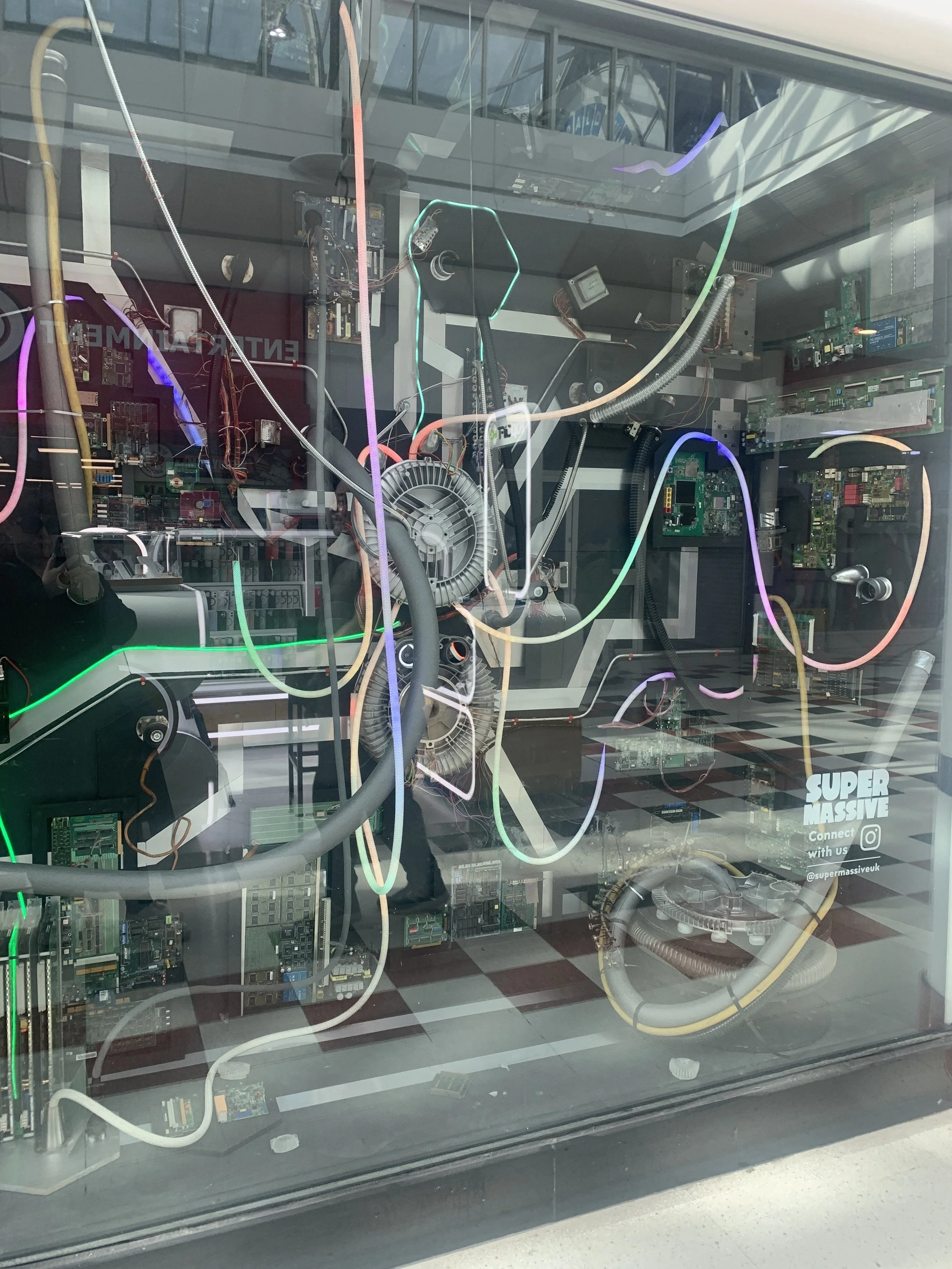
The Immersive Lens Blog 2
Who is immersive work really for?
Beyond the buzzwords
As immersive practice gains visibility across funding, technology and culture sectors, it is easy to focus solely on innovation. But equally important is access.
Who gets to make immersive work? Who gets to experience it? And how do we build for inclusion, not only impact?
In The Immersive Lens, supported by The National Lottery via Creative Scotland, we met with practitioners across the UK who are helping shape the future of immersive media. Their reflections made one point clear. For immersive work to matter, it must be equitable.
Those Who Hold Up The Sky, Brightblack and Fusion Factory, immersive event and exhibition artists talk, Aviva Studios Manchester, March 2025 Image © SUUM studio
Co-creation, not spectatorship
Immersive work is often praised for being engaging, but for whom? Several practitioners raised questions about agency and involvement.
“Immersive shouldn’t just be something people watch, it is something they are part of. That means building systems where they can explore, impact and even change the work.” - Sam Hunt, Chief Creative Officer, AIX Live
“In our projects, the audience is part of the piece. Their presence, their choices, change the outcome. That is where the power lies.” - Simon Wilkinson, Co-Director, Brightblack
“In our first show, the audience voted on which actor they thought was AI and which was the real human being. We had two endings. The audience made that choice. That was amazing.” - Bo Warner, Co-Artistic Director, Quantum Egg Theatre
Louis Schamroth-Green, Creative Director at Supermassive UK, described audience agency as central to their work.
“We want our spaces to be chaotic. Visitors should be able to create their own experiences. If a child blocks an entrance in the cube room, that is great. The audience shapes the experience.”
Across these conversations, co-creation emerged as a shared priority, not only in form but in intention.
At Suum Studio, we see immersive practice as a conversation, not a monologue. Whether through projection, real-time environments or augmented space, the most meaningful experiences are those in which audiences feel invited to shape the work.
The Herds, large scale public and community art procession, Manchester City Centre, July 2025 Image © SUUM studio
Barriers to entry
Participation is not always possible. Barriers remain across the sector, from the cost of equipment to the resource required even for small-scale hosting. Does immersive work need to be large-scale to justify investment?
At Frameless Creative x National Portrait Gallery in MediaCity, the presentation was expertly designed, with a clear booking system, warm hospitality and an accessible ticket price. Yet participation remained minimal. Visitors watched, moved for a better viewpoint and absorbed the projections, but stayed outside the experience. This revealed a tension between immersive as spectacle and immersive as agency.
By contrast, Supermassive UK created multiple entry points for co-creation at their Depot Mayfield experience. Visitors generated AI artworks through voice prompts, shaped soundscapes using illuminated tubes and remixed audio with magnetic tiles. Louis reflected on the need to communicate the experience clearly: “I struggle with the term ‘art’ because it feels distancing. I prefer ‘experience’ or ‘playground’ because it feels more accessible. But calling it a playground set the wrong expectations for parents, so we reintroduced the term ‘art experience’ to help people understand what it is.”
Their accessible ticketing model, including plans for community pricing, demonstrated how participation can be expanded by reducing financial barriers.
Factory International also demonstrated how access can be embedded at a systemic level. Aviva Studios hosts a wide range of programming, from large-scale performances to artist-led workshops and public events, with many activities offered at no cost and others priced at an accessible level. During our visit, tickets for major performances such as the reimagined Hamlet were available for ten pounds, a deliberate effort to remove financial barriers even for high-profile work. The venue’s approach aligns with emerging models such as Supermassive UK’s community pricing, positioning accessibility not as an optional add-on but as a core principle of cultural programming.
During our July research trip, Manchester also offered a free bus service that connected key areas of the city throughout the day and evening. This made it possible to travel between venues, installations and neighbourhoods without cost, further reducing barriers to participation. These forms of civic infrastructure, although not always discussed alongside immersive work, have a direct impact on who can access culture and how easily people can move through a creative ecosystem.
Echo Salford also demonstrated how access can be expanded beyond traditional cultural venues. Their free immersive music heritage trail invited visitors to explore the city’s world-renowned independent music history through interactive soundscapes and storytelling woven into public routes. It reactivated local heritage while remaining entirely free to experience, creating an open, self-guided form of immersion that did not require ticketing or specialist equipment.
Taken together with The Herds, Trespass and Factory International’s accessible pricing, these examples highlight a wider cultural pattern across Manchester. Much of what we encountered during our trip was either free or donation based, and the events that did charge offered clear, varied entry points to ensure people could participate. This reinforced a consistent ethos across the city. Immersion is not only a creative approach, it is supported by infrastructure, transport, place-making and a civic commitment to reducing barriers.
“We talk about immersion, but who is being immersed? If it is the same people in the room each time, we are not evolving the medium.” - Anny Deery, Producer, Inner Ear UK
We also saw inclusive design approaches across Manchester, from mobile-first augmented environments to sensory-led installations. However, many practitioners shared that inclusion is still treated as an enhancement rather than a foundation.
Echo Salford Immersive Music Culture and Heritage Trail, Manchester, July 2025 Image © SUUM studio
Community-led models of participation
Manchester International Festival’s opening performance of The Herds demonstrated how immersive work can be civic, communal and accessible. Seventy life-sized puppet animals travelled through the city centre, accompanied by Manchester Camerata musicians and performers from Global Grooves. The scale was ambitious, yet its strength lay in its participation structure. Local community groups were involved in designing, building and performing the work, and the route took place entirely in public space. There was no ticket price, no entry threshold and no fixed audience boundary. The work met people where they were.
It was an example of immersion built on openness rather than exclusivity, showing that large-scale work can be accessible without reducing impact.
Trespass at Factory International adopted a different but equally inclusive approach. A mobile-first augmented reality experience, it transformed parts of the building and surrounding space through a free AR app. Visitors could explore at their own pace, with no time limit and no ticket. The only requirement was access to a mobile phone, making it one of the most accessible immersive experiences we encountered during the trip.
These projects reminded us that inclusion is not only about pricing or outreach. It is about designing works that remove friction and allow audiences to participate on their own terms.
Who gets to make it?
Access affects the makers as much as the audience.
Across our research, practitioners described fragmented support structures, from ad hoc opportunities to short-term funding cycles. These limitations disproportionately affect early-career creatives and underrepresented communities.
In Greater Manchester, a more active ecosystem supports creative development. Salford City Council regularly shares open calls, paid projects, networking events and training opportunities for local creatives. MediaCity UK and Factory International publish frequent calls for artists, producers and technologists, creating a consistent and well-connected environment for digital and immersive practitioners.
HOME Manchester’s Arches spaces provide free residency studios to creatives who have been displaced from the city centre due to rising costs. HOME’s Art Development Officer Isabelle Croissant described the importance of accessible space.
“People do not need a lot to get started, but they do need space and someone to talk to who understands the work they are trying to do. That is why having places like the Arches is so important. You can come in with an idea and have room to test it.”
Bo Warner, an artist in residence when we visited, highlighted the value of equitable opportunities.
“It is a bit of a chicken and egg situation. Training only gets you so far. You need to actually be given the chance to do something. That is what makes the Arches such a good resource.”
Those Who Hold Up The Sky, Brightblack and Fusion Factory, 3D character making and live photogrammetry, Aviva Studios Manchester, March 2025 Image © SUUM studio
The Scottish landscape
In Scotland, investment in immersive and digital infrastructure is increasing. The CoSTAR Realtime Lab is backed by a £75.6 million UKRI Infrastructure Fund grant and delivered by AHRC, Abertay University and the University of Edinburgh, with support from Screen Scotland, the Scottish Games Network and the Edinburgh Futures Institute. It represents a major step in national capability building. The programme includes a £9 million virtual production facility in Dundee, with further facilities planned in Edinburgh. Together, these developments signal a long-term commitment to research and technical capacity.
However, the picture is more complex when viewed from the perspective of practitioners working in the immersive sector. Much of the current investment is routed through academic partnerships and institutional development rather than industry. As practitioners working at the intersection of art, design and real-time media, we see a gap between the scale of this investment and the support available to the companies expected to use these facilities. While the infrastructure grows, industry is still self-funding the development of new IP, production methods and business systems. Without long-term, industry-facing investment that supports practitioners, studios and production companies directly, Scotland risks building capability without resourcing the people who will test, innovate and animate these environments.
HOME Manchester, Arches, Studio and Residency space, Arch 1, Manchester, July 2025 Image © SUUM studio
Investment in Industry and Institutions
This challenge is not unique to Scotland. Across the UK, our interviewees repeatedly highlighted the need for investment in practitioners and companies alongside investment in institutions. Several of them described a growing gap between the rapid evolution of immersive technologies and the slower pace of infrastructure, policy and funding models.
Sam Hunt noted that while venue and platform development is important, sustainable growth comes from supporting the people who create the work: “Immersive systems need artists and producers who understand how to build worlds, not just places to put the work. If you do not invest in the people who know how to use these tools, the infrastructure will not fulfil its potential.”
Myra Appannah echoed this, stressing that access to technology is only one part of the picture: “Real time tools are becoming more accessible, but that does not remove the need for long term investment in practitioners. You cannot build a sector without supporting the people who drive it.”
Simon Wilkinson also pointed to the pressures faced by independent companies who operate without stable support structures.
“The work takes years of experimentation. You need time and space to try ideas that may not become projects straight away. That kind of development is rarely funded.”
Producer Mark Ashmore described this imbalance in economic terms, emphasising that audiences, practitioners and small studios are often the ones sustaining the field through their own labour and investment.
“The government is often ten years behind industry trends. They fund things without developing audiences or new spaces. We have been self-sufficient for 15 years by earning directly from audiences. You need to understand why they would pay and what they need.”
Together, these perspectives show that immersive practice requires more than facilities, labs or new technical spaces. It depends on practitioners who can develop ideas, test prototypes, collaborate, build audiences and sustain creative businesses. Without targeted investment in the people who shape the work, even the most advanced infrastructure struggles to deliver its full cultural or economic value.
From our perspective as a studio working in immersive design, sustainable innovation depends not only on access to technology, but on the ability of practitioners to experiment, iterate and build new work without prohibitive financial risk.
While opportunities exist across Creative Scotland, Scottish Enterprise, Codebase, Techscaler and Immersive Arts UK (delivered by Cryptic), these sit across different sectors and are not yet knitted into a coherent pathway. Residencies tend to prioritise traditional artforms more consistently than immersive technologies.
Scotland does have emerging initiatives that support immersive and digital practice, including university-based XR labs, innovation studios and artist networks. However, there is not yet a hub that combines free or low-cost studio space, cross-sector infrastructure and open access in the way that HOME’s Arches, Salford or MediaCity currently do. The existing offer is often tied to institutions, specific programmes or membership models, which can make it harder for independent practitioners and small studios to navigate and sustain early-stage immersive work.
With a smaller and more concentrated central belt, and increasing living and working costs pushing creatives further from cities, Scotland may benefit from a more decentralised and distributed approach to creative infrastructure.
Supermassive UK, Motion reactive Sandbox, Depot Mayfield, Manchester, July 2025 Image © SUUM studio
Shifts in practice and participation
Myra Appannah reflected on several systemic shifts that continue to shape access and inclusion within immersive practice. She noted that real-time tools are becoming more widely available, creating new opportunities for artists who previously lacked access to advanced technology.
“Unity and other real-time engines are now accessible to artists. These tools are democratising how people can work with immersive and convergent technologies.”
She also described changes in the sector’s demographics and power structures, particularly as commercial interests expanded. “The immersive space was initially female dominated, coming out of theatre, but around 2015 it became more male dominated and commercialised as industry players entered the field.”
Looking ahead, she emphasised the need for adaptability, both for individual practitioners and for the organisations that support them: “To survive, we have had to diversify. Five year plans do not work in our field. You need a flexible, day to day strategy.”
Producer Mark Ashmore highlighted how community-led models can strengthen the wider immersive ecosystem. He described an open culture in Manchester, where sharing knowledge and making space for collaboration are treated as essential parts of creative practice: “Manchester has an open door culture. People share research, make time for others and invite each other into projects. That builds the community. We prefer working on the outskirts, in the counterculture, because that is where the impact happens.”
Finally, he emphasised that long-term investment in people is essential to sustainability, innovation and growth: “Funding gets spread too thinly. We need long term investment in experienced people. When you invest in the coaches, you get breakthroughs. We need that in immersive tech and AI.”
Supermassive UK, Projection Mapping Play Blocks, Depot Mayfield, Manchester, July 2025 Image © SUUM studio
An open invitation
If immersive practice is to fulfil its potential, creatively and socially, it must ask harder questions about access, power and participation.
At Suum Studio, we are considering how our practice can centre inclusion, both in who we reach and in how we design and co-create. As part of this project, we are forming a small, evolving network drawn from our interviewees and participants. This group will continue sharing learning through an open Discord server, initiated by Jed Ashforth of Realised Realities, to support ongoing discussion and collaboration.
Because immersive work, at its best, is not about walls or headsets. It is about opening doors.
Join The Immersive Lens Discord Forum here: JOIN
Coming soon
This post is part of The Immersive Lens, a blog and vlog series by Suum Studio.
Next up: Blog 3 - What does it take to sustain an immersive practice?
Subscribe to SUUM NEWS or follow us on LinkedIn, TikTok and Instagram for behind-the-scenes content, new posts and future collaborations.
About The Immersive Lens
This blog is part of The Immersive Lens, a Creative Scotland–supported research project by SUUM Studio. With funding from the National Lottery through Creative Scotland’s Go See Share programme, we travelled to Manchester to explore how immersive creatives across the UK are sustaining their work, creatively, financially, and emotionally.
Over the course of the project, we engaged with more than 20 practitioners working at the intersection of immersive arts, technology, design, and storytelling. We visited exhibitions, attended public and industry events, and held in-depth interviews with artists, technologists, curators, producers, and strategists shaping the future of immersive practice.
What we heard, and what we saw, is shaping this blog and vlog series. Each post will share insights, provocations, and reflections drawn from our field research, in the hope that they’ll support others navigating this evolving landscape.
The Immersive Lens was supported by the National Lottery through Creative Scotland.
Image credits:
Header image - Supermassive UK Salford Shopping Centre, March 2025
Image 1 - Those Who Hold Up The Sky, Brightblack and Fusion Factory, immersive event and exhibition artists talk, Aviva Studios Manchester, March 2025
Image 2 - The Herds, large scale public and community art procession, Manchester City Centre, July 2025
Image 3 - Echo Salford Immersive Music Culture and Heritage Trail, Manchester, July 2025
Image 4 - Those Who Hold Up The Sky, Brightblack and Fusion Factory, 3D character making and live photogrammetry, Aviva Studios Manchester, March 2025
Image 5- HOME Manchester, Arches, Studio and Residency space, Arch 1, Manchester, July 2025
Image 6 - Supermassive UK, Motion reactive Sandbox, Depot Mayfield, Manchester, July 2025
Image 7 - Supermassive UK, Projection Mapping Play Blocks, Depot Mayfield, Manchester, July 2025
Footer image - Frameless x National Portrait Gallery, Stories Brought To Life, Photographic immersive installation, MediaCity, Salford, July 2025
All images © SUUM studio unless otherwise stated


